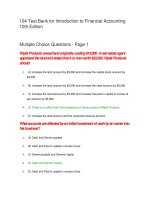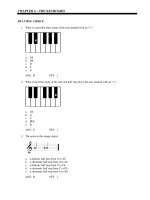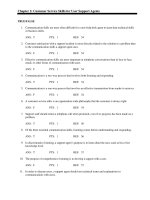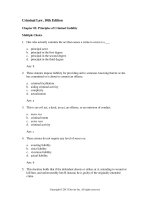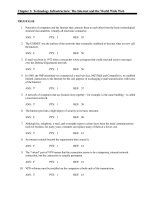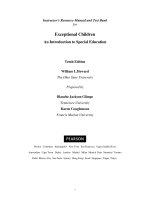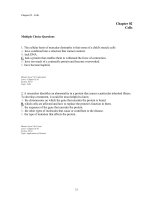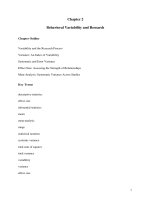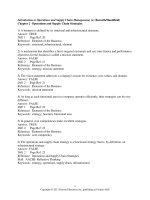Introduction to operations research 10th edition fred hillier test bank
Bạn đang xem bản rút gọn của tài liệu. Xem và tải ngay bản đầy đủ của tài liệu tại đây (3.14 MB, 36 trang )
Test Bank for Chapter 3
Problem 3-1:
The Weigelt Corporation has three branch plants with excess production capacity.
Fortunately, the corporation has a new product ready to begin production, and all three
plants have this capability, so some of the excess capacity can be used in this way. This
product can be made in three sizes--large, medium, and small--that yield a net unit profit
of $420, $360, and $300, respectively. Plants 1, 2, and 3 have the excess capacity to
produce 750, 900, and 450 units per day of this product, respectively, regardless of the
size or combination of sizes involved.
The amount of available in-process storage space also imposes a limitation on the
production rates of the new product. Plants 1, 2, and 3 have 13,000, 12,000, and 5,000
square feet, respectively, of in-process storage space available for a day's production of
this product. Each unit of the large, medium, and small sizes produced per day requires
20, 15, and 12 square feet, respectively.
Sales forecasts indicate that if available, 900, 1,200, and 750 units of the large,
medium, and small sizes, respectively, would be sold per day.
At each plant, some employees will need to be laid off unless most of the plant’s
excess production capacity can be used to produce the new product. To avoid layoffs if
possible, management has decided that the plants should use the same percentage of their
excess capacity to produce the new product.
Management wishes to know how much of each of the sizes should be produced
by each of the plants to maximize profit.
Formulate a linear programming model for this problem.
Solution for Problem 3.1:
The decision variables can be denoted and defined as follows:
xP1L
xP1M
xP1S
xP2L
xP2M
xP2S
xP3L
xP3M
xP3S
=
=
=
=
=
=
=
=
=
number of large units produced per day at Plant 1,
number of medium units produced per day at Plant 1,
number of small units produced per day at Plant 1,
number of large units produced per day at Plant 2,
number of medium units produced per day at Plant 2,
number of small units produced per day at Plant 2,
number of large units produced per day at Plant 3,
number of medium units produced per day at Plant 3,
number of small units produced per day at Plant 3.
Also letting P (or Z) denote the total net profit per day, the linear programming model for
this problem is
Maximize P = 420 xP1L + 360 xP1M + 300 xP1S + 420 xP2L + 360 xP2M + 300 xP2S
+ 420 xP3L + 360 xP3M + 300 xP3S,
subject to
xP1L + xP1M + xP1S 750
xP2L + xP2M + xP2S 900
xP3L + xP3M + xP3S 450
20 xP1L + 15 xP1M + 12 xP1S 13000
20 xP2L + 15 xP2M + 12 xP2S 12000
20 xP3L + 15 xP3M + 12 xP3S 5000
xP1L + xP2L + xP3L
900
xP1M + xP2M + xP3M 1200
xP1S + xP2S + xP3S
750
1
1
( xP1L + xP1M + xP1S ) ( xP2L + xP2M + xP2S ) = 0
750
900
1
1
( xP1L + xP1M + xP1S ) ( xP3L + xP3M + xP3S ) = 0
750
450
and
xP1L 0, xP1M 0, xP1S 0, xP2L 0, xP2M 0, xP2S 0,
xP3L 0, xP3M 0, xP3S 0.
The above set of equality constraints also can include the following constraint:
1
( x P2 L + x P2 M + x P2S ) - 1 (x P3 L + xP3M + x P3S ) = 0.
900
450
However, any one of the three equality constraints is redundant, so any one (say, this one)
can be deleted.
Problem 3-2:
Comfortable Hands is a company which features a product line of winter gloves for the
entire family — men, women, and children. They are trying to decide what mix of these
three types of gloves to produce.
Comfortable Hands’ manufacturing labor force is unionized. Each full-time
employee works a 40-hour week. In addition, by union contract, the number of full-time
employees can never drop below 20. Nonunion, part-time workers can also be hired with
the following union-imposed restrictions: (1) each part-time worker works 20 hours per
week, and (2) there must be at least 2 full-time employees for each part-time employee.
All three types of gloves are made out of the same 100% genuine cowhide leather.
Comfortable Hands has a long term contract with a supplier of the leather, and receives a
5,000 square feet shipment of the material each week. The material requirements and
labor requirements, along with the gross profit per glove sold (not considering labor
costs) is given in the following table.
Material Required
Labor Required
Gross Profit
Glove
(square feet)
(minutes)
(per pair)
Men’s
2
30
$8
Women’s
1.5
45
$10
Children’s
1
40
$6
Each full-time employee earns $13 per hour, while each part-time employee earns
$10 per hour. Management wishes to know what mix of each of the three types of gloves
to produce per week, as well as how many full-time and how many part-time workers to
employ. They would like to maximize their net profit — their gross profit from sales
minus their labor costs.
Formulate a linear programming model for this problem.
Solution for Problem 3-2:
The decision variables can be denoted and defined as follows:
M = number of men’s gloves to produce per week,
W = number of women’s gloves to produce per week,
C = number of children’s gloves to produce per week,
F = number of full-time workers to employ,
PT = number of part-time workers to employ.
(Alternative notation for the decision variables is xM, xW, xC, xF, and xPT, respectively.)
Also letting P (or Z) denote the total net profit per week, the linear programming model
for this problem is
Maximize P = 8 M + 10 W + 6 C – 13(40)F – 10(20) PT,
subject to
2 M + 1.5 W + C 5000
30 M + 45 W + 40 C 40(60) F + 20(60) PT
F 20
F 2 PT
and
M 0, W 0, C 0,
F 0,
PT 0.
Problem 3-3:
Slim-Down Manufacturing makes a line of nutritionally complete, weight-reduction
beverages. One of their products is a strawberry shake which is designed to be a complete
meal. The strawberry shake consists of several ingredients. Some information about each
of these ingredients is given below.
Calories
Total
Vitamin
from fat
Calories
Content
Thickeners
Cost
(per tbsp)
(per tbsp)
(mg/tbsp)
(mg/tbsp)
(¢/tbsp)
1
50
20
3
10
75
100
0
8
8
Vitamin supplement
0
0
50
1
25
Artificial sweetener
0
120
0
2
15
30
80
2
25
6
Ingredient
Strawberry flavoring
Cream
Thickening agent
The nutritional requirements are as follows. The beverage must total between 380
and 420 calories (inclusive). No more than 20% of the total calories should come from
fat. There must be at least 50 milligrams (mg) of vitamin content. For taste reasons, there
must be at least two tablespoons (tbsp) of strawberry flavoring for each tbsp of artificial
sweetener. Finally, to maintain proper thickness, there must be exactly 15 mg of
thickeners in the beverage.
Management would like to select the quantity of each ingredient for the beverage
which would minimize cost while meeting the above requirements.
Formulate a linear programming model for this problem.
Solution for Problem 3-3:
The decision variables can be denoted and defined as follows:
S = Tablespoons of strawberry flavoring,
CR = Tablespoons of cream,
V = Tablespoons of vitamin supplement,
A = Tablespoons of artificial sweetener,
T = Tablespoons of thickening agent.
(Alternative notation for the decision variables is xS, xC, xV, xA, and xT, respectively.)
Also letting C (or Z) denote cost, the linear programming model for this problem is
Minimize C = 10 S + 8 CR + 25 V + 15 A + 6 T,
subject to
50 S + 100 CR + 120 A + 80 T 380
50 S + 100 CR + 120 A + 80 T 420
S + 75 CR + 30 T 0.2 (50 S + 100 CR + 120 A + 80 T)
20 S + 50 V + 2 T ≥ 50
S 2A
3 S + 8 CR + V + 2 A + 25 T = 15
and
S 0, CR 0, V 0, A 0, T 0.
Problem 3-4:
Back Savers is a company that produces backpacks primarily for students. They are
considering offering some combination of two different models—the Collegiate and the
Mini. Both are made out of the same rip-resistant nylon fabric. Back Savers has a longterm contract with a supplier of the nylon and receives a 5000 square-foot shipment of
the material each week. Each Collegiate requires 3 square feet while each Mini requires 2
square feet. The sales forecasts indicate that at most 1000 Collegiates and 1200 Minis can
be sold per week. Each Collegiate requires 45 minutes of labor to produce and generates
a unit profit of $32. Each Mini requires 40 minutes of labor and generates a unit profit of
$24. Back Savers has 35 laborers that each provides 40 hours of labor per week.
Management wishes to know what quantity of each type of backpack to produce per
week.
(a) Formulate and solve a linear programming model for this problem on a spreadsheet.
(b) Formulate this same model algebraically.
(c) Use the graphical method by hand to solve this model.
Solution for Problem 3-4:
(a)
To build a spreadsheet model for this problem, start by entering the data. The data for this
problem are the unit profit of each type of backpack, the resource requirements (square
feet of nylon and labor hours required), the availability of each resource, 5400 square feet
of nylon and (35 laborers)(40 hours/laborer) = 1400 labor hours, and the sales forecast for
each type of backpack (1000 Collegiates and 1200 Minis). In order to keep the units
consistent in row 8 (hours), the labor required for each backpack (in cells C8 and D8) are
converted from minutes to hours (0.75 hours = 45 minutes, 0.667 hours = 40 minutes).
The range names UnitProfit (C4:D4), Available (G7:G8), and SalesForecast (C13:D13)
are added for these data.
The decision to be made in this problem is how many of each type of backpack to make.
Therefore, we add two changing cells with range name UnitsProduced (C11:D11). The
values in CallsPlaced will eventually be determined by the Solver. For now, arbitrary
values of 10 and 10 are entered.
The goal is to produce backpacks so as to achieve the highest total profit. Thus, the
objective cell should calculate the total profit, where the objective will be to maximize
this objective cell. In this case, the total profit will be
Total Profit = ($32)(# of Collegiates) + ($24)(# of Minis)
or
Total Cost = SUMPRODUCT(UnitProfit, UnitsProduced).
This formula is entered into cell G11 and given a range name of TotalProfit. With 10
Collegiates and 10 Minis produced, the total profit would be ($32)(10) + ($24)(10) =
$560.
The first set of constraints in this problem involve the limited available resources (nylon
and labor hours). Given the number of units produced (UnitsProduced in C11:D11), we
calculate the total resources required. For nylon, this will be =SUMPRODUCT(C7:D7,
UnitsProduced) in cell E7. By using a range name or an absolute reference for the units
produced, this formula can be copied into cell E8 to calculate the labor hours required.
The total resources used (TotalResources in E7:E8) must be <= Available (in cells
G7:G8), as indicated by the <= in F7:F8.
The final constraint is that it does not make sense to produce more backpacks than can be
sold (as predicted by the sales forecast). Therefore UnitsProduced (C11:D11) should be
less-than-or-equal-to the SalesForecast (C13:D13), as indicated by the <= in C12:D12
The Solver information and solved spreadsheet are shown below.
Solver Parameters
Set Objective Cell: TotalProfit
To: Max
By Changing Variable Cells:
UnitsProduced
Subject to the Constraints:
TotalRequired <= Available
UnitsProduced <= SalesForecast
Solver Options:
Make Variables Nonnegative
Solving Method: Simplex LP
Range Name
Available
SalesForecast
TotalProfit
TotalRequired
UnitProfit
UnitsProduced
Cells
G7:G8
C13:D13
G11
E7:E8
C4:D4
C11:D11
Thus, they should produce 1000 Collegiates and 975 Minis to achieve the maximum total
profit of $55,400.
(b)
To build an algebraic model for this problem, start by defining the decision variables. In
this case, the two decisions are how many Collegiates to produce and how many Minis to
produce. These variables are defined below:
Let
C = Number of Collegiates to produce,
M = Number of Minis to produce.
Next determine the goal of the problem. In this case, the goal is to produce the number of
each type of backpack to achieve the highest possible total profit. Each Collegiate yields
a unit profit of $32 while each Mini yields a unit profit of $24. The objective function is
therefore
Maximize Total Profit = $32C + $24M.
The first set of constraints in this problem involve the limited resources (nylon and labor
hours). Given the number of backpacks produced, C and M, and the required nylon and
labor hours for each, the total resources used can be calculated. These total resources
used need to be less than or equal to the amount available. Since the labor available is in
units of hours, the labor required for each backpack needs to be in units of hours (3/4
hour and 2/3 hour) rather than minutes (45 minutes and 40 minutes). These constraints
are as follows:
Nylon:
Labor Hours:
3C + 2M ≤ 5400 square feet,
(3/4)C + (2/3)M ≤ 1400 hours.
The final constraint is that they should not produce more of each backpack than the sales
forecast. Therefore,
Sales Forecast:
C ≤ 1000
M ≤ 1200.
After adding nonnegativity constraints, the complete algebraic formulation is given
below:
Let
C = Number of Collegiates to produce,
M = Number of Minis to produce.
Maximize Total Profit = $32C + $24M,
subject to
Nylon:
Labor Hours:
Sales Forecast:
and C ≥ 0, M ≥ 0.
(c)
3C + 2M ≤ 5400 square feet,
(3/4)C + (2/3)M ≤ 1400 hours,
C ≤ 1000
M ≤ 1200.
Start by plotting a graph with Collegiates (C) on the horizontal axis and Minis (M) on the
vertical axis, as shown below.
Next, the four constraint boundary lines (where the left-hand-side of the constraint
exactly equals the right-hand-side) need to be plotted. The easiest way to do this is by
determining where these lines intercepts the two axes. For the Nylon constraint boundary
line (3C + 2M = 5400), setting M = 0 yields a C-intercept of 1800 while setting C = 0
yields an M-intercept of 2700. For the Labor constraint boundary line ((3/4)C + (2/3)M =
1400), setting M = 0 yields a C-intercept of 1866.67 while setting C = 0 yields an Mintercept of 2100. The sales forecast constraints are a horizontal line at M = 1200 and a
vertical line at C = 1000. These constraint boundary lines are plotted below.
A feasible solution must be below and/or to the left of all four of these constraints while
being above the Collegiate axis (since C ≥ 0) and to the right of the Mini axis (since M ≥
0). This yields the feasible region shown below.
To find the optimal solution, an objective function line is plotted by setting the objective
function equal to a value. For example, the objective function line when the value of the
objective function is $48,000 is plotted as a dashed line below.
All objective function lines will be parallel to this one. To find the feasible solution that
maximizes profit, slide this line out as far as possible while still touching the feasible
region. This occurs when the profit is $55,400, and the objective function line intersect
the feasible region at the single point with (C, M) = (1000, 975) as shown below.
Therefore, the optimal solution is to produce 1000 Collegiates and 975 Minis, yielding a
total profit of $55,400.
Problem 3-5:
The marketing group for a cell phone manufacturer plans to conduct a telephone survey
to determine consumer attitudes toward a new cell phone that is currently under
development. In order to have a sufficient sample size to conduct the analysis, they need
to contact at least 100 young males (under age 40), 150 older males (over age 40), 120
young females (under age 40), and 200 older females (over age 40). It costs $1 to make a
daytime phone call and $1.50 to make an evening phone call (due to higher labor costs).
This cost is incurred whether or not anyone answers the phone. The table below shows
the likelihood of a given customer type answering each phone call. Assume the survey is
conducted with whoever first answers the phone. Also, because of limited evening
staffing, at most one-third of phone calls placed can be evening phone calls. How should
the marketing group conduct the telephone survey so as to meet the sample size
requirements at the lowest possible cost?
Who Answers?
Daytime Calls
Evening Calls
Young Male
10%
20%
Older Male
15%
30%
Young Female
20%
20%
Older Female
35%
25%
No Answer
20%
5%
(a) Formulate and solve a linear programming model for this problem on a spreadsheet.
(b) Formulate this same model algebraically.
Solution for Problem 3-5:
(a)
To build a spreadsheet model for this problem, start by entering the data. The data for this
problem are the cost of each type of phone call, the percentages of each customer type
answering each type of phone call, and the total number of each customer type needed for
the survey.
The decision to be made in this problem is how many of each type of phone call to make.
Therefore, we add two changing cells with range name CallsPlaced (C13:D13). The
values in CallsPlaced will eventually be determined by the Solver. For now, arbitrary
values of 10 and 5 are entered.
The goal of the marketing group is to conduct the survey at the lowest possible cost.
Thus, the objective cell should calculate the total cost, where the objective will be to
minimize this objective cell. In this case, the total cost will be
Total Cost = ($1)(# of daytime calls) + ($1.50)(# of evening calls)
or
Total Cost = SUMPRODUCT(UnitCost, CallsPlaced).
This formula is entered into cell G13 and given a range name of TotalCost. With 10
daytime phone calls and 5 evening calls, the total cost would be ($1)(10) + ($1.50)(5) =
$17.50.
The first set of constraints in this problem involve the minimum responses required from
each customer group. Given the number of calls placed (CallsPlaced in C13:D13), we
calculate the total responses by each customer type. For young males, this will be
=SUMPRODUCT(C7:D7, CallsPlaced). By using a range name or an absolute reference
for the calls placed, this formula can be copied into cells E8-E10 to calculate the number
of older males, young females, and older females reached. The total responses of each
customer type (Total Responses in E7:E10) must be >= ResponsesNeeded (in cells
G7:G10), as indicated by the >= in F7:F10.
The final constraint is that at most one third of the total calls placed can be evening calls.
In other words:
Evening Calls <= (1/3)(Total Calls Placed)
The two sides of this constraint (i.e., evening calls and 1/3 of total calls placed) are
calculated in cells C15 and E15. Enter <= in D15 to show that C15 <= E15.
The Solver information and solved spreadsheet are shown below.
Solver Parameters
Set Objective Cell: TotalCost
To: Min
By Changing Variable Cells:
CallsPlaced
Subject to the Constraints:
EveningCalls <= E15
TotalResponses >= ResponsesNeeded
Solver Options:
Make Variables Nonnegative
Solving Method: Simplex LP
Range Name
CallsPlaced
EveningCalls
ResponsesNeeded
TotalCost
TotalResponses
UnitCost
Cells
C13:D13
C15
G7:G10
G13
E7:E10
C4:D4
Thus, the marketing group should place 500 daytime calls and 250 evening calls at a total
cost of $875.
(b)
To build an algebraic model for this problem, start by defining the decision variables. In
this case, the two decisions are how many daytime calls and how many evening calls to
place. These variables are defined below:
Let
D = Number of daytime calls to place
E = Number of evening calls to place.
Next determine the goal of the problem. In this case, the goal is to conduct the marketing
survey at the lowest possible cost. Each daytime call costs $1 while each evening call
costs $1.50. The objective function is therefore
Minimize Total Cost = $1D + $1.50E.
The first set of constraints in this problem involve the minimum responses required from
each customer group. Given the number of calls place, D and E, and the percentage of
calls answered by each customer group, the total responses for each customer group is
calculated. These total responses need to be greater than or equal to the minimum
responses required. These constraints are as follows:
Young Males:
Older Males:
Young Females:
Older Females:
(10%)D + (20%)E ≥ 100
(15%)D + (30%)E ≥ 150
(20%)D + (20%)E ≥ 120
(35%)D + (25%)E ≥ 200.
The final constraint is that at most one third of the total calls placed can be evening calls.
In other words:
Evening Calls <= (1/3)(Total Calls Placed)
Substituting E for Evening Calls, and D + E for Total Calls Placed yields the following
constraint:
E ≤ (1/3)(D + E).
After adding nonnegativity constraints, the complete algebraic formulation is given
below:
Let
D = Number of daytime calls to place
E = Number of evening calls to place.
Minimize Total Cost = $1D + $1.50E.
subject to
Young Males:
Older Males:
Young Females:
Older Females:
Evening Call Ratio:
and D ≥ 0, E ≥ 0.
(10%)D + (20%)E ≥ 100
(15%)D + (30%)E ≥ 150
(20%)D + (20%)E ≥ 120
(35%)D + (25%)E ≥ 200
E ≤ (1/3)(D + E)
Problem 3-6
Dwight and Hattie have run the family farm for over thirty years. They are currently
planning the mix of crops to plant on their 120-acre farm for the upcoming season. The
table below gives the labor hours and fertilizer required per acre, as well as the total
expected profit per acre for each of the potential crops under consideration. Dwight,
Hattie, and their children can work at most 6,500 total hours during the upcoming season.
They have 200 tons of fertilizer available. What mix of crops should be planted to
maximize the family’s total profit?
Labor Required
Fertilizer Required
Expected Profit
Crop
(hours per acre)
(tons per acre)
(per acre)
Oats
50
1.5
$500
Wheat
60
2
$600
Corn
105
4
$950
(a) Formulate and solve a linear programming model for this problem in a spreadsheet.
(b) Formulate this same model algebraically.
Solution for Problem 3-6:
(a)
This is a resource-allocation problem. The activities are the planting of the three crops
and the limited resources are land, labor, and fertilizer. We will start to build a
spreadsheet by entering the data. The data for this problem are the labor required,
fertilizer required, and expected profit for each crop (per acre). The data in the
spreadsheet would be entered as displayed below, where range names of ProfitPerAcre
(C4:E4) and TotalAvailable (H7:H9) are assigned to the corresponding data cells.
The decisions to be made in this problem are how many acres of each crop to plant.
Therefore, we add three changing cells in C12:E12 with range name AcresPlanted. The
values in AcresPlanted (C12:E12) will eventually be determined by the Solver. For now,
an arbitrary value of 1 is entered for each crop.
The goal is to maximize the family’s total profit. Thus, the objective cell should calculate
the total profit. In this case, the total profit will be
Total Profit = ($500)(acres of oats) + ($600)(acres of wheat) + ($950)(acres of
corn)
or
Total Profit = SUMPRODUCT(ProfitPerAcre, AcresPlanted).
This formula is entered into cell H12. With 1 acre of each crop planted, the total cost
would be ($500)(1) + ($600)(1) + ($950)(1) = $2,050.
The functional constraints in this problem involve the limited resources of land, labor,
and fertilizer. Given the AcresPlanted (the changing cells in C12:E12), we calculate the
total resources used in TotalUsed (cells F7:F9). For land, this will be
=SUMPRODUCT(C7:E7, AcresPlanted). Using a range name or an absolute reference
for the acres planted, this formula can be copied into cells F8:F9 to calculate the amount
of labor and fertilizer used. The total resources used must be <= TotalAvailable (H7:H9),
as indicated by the <= in G7:G9.
The Solver information and solved spreadsheet are shown below.
Solver Parameters
Set Objective Cell: TotalProfit
To: Max
By Changing Variable Cells:
AcresPlanted
Subject to the Constraints:
TotalUsed <= TotalAvailable
Solver Options:
Make Variables Nonnegative
Solving Method: Simplex LP
Range Name
AcresPlanted
ProfitPerAcre
TotalAvailable
TotalProfit
TotalUsed
Cells
C12:E12
C4:E4
H7:H9
H12
F7:F9
Thus, oats should be planted on 80 acres and wheat on 40 acres, while not planting any
corn, with a resulting total profit of $64,000.
(b)
To build an algebraic model for this problem, start by defining the decision variables. In
this case, the three decisions are how many acres of oats, wheat, and corn to plant. These
variables are defined below:
Let
O = Acres of oats planted,
W = Acres of wheat planted,
C = Acres of corn planted.
Next determine the goal of the problem. In this case, the goal is to achieve the highest
possible total profit. Each acre of oats yields a profit of $500, each acre of wheat yields a
profit of $600, while each acre of corn yields a profit of $950. The objective function is
therefore
Maximize Total Profit = $500O + $600W + $950C.
There are three limited resources in this problem: 120 acres of land, 6500 hours of labor,
and 200 tons of fertilizer. Each acre of a given crop that is planted uses up one available
acre. The data for labor hours used and fertilizer used per acre planted can be used to
calculate the total resources used as a function of the decision variables. The total
resources used need to be less than or equal to the amount available. These constraints are
therefore as follows:
Land:
Labor:
Fertilizer:
O + W + C ≤ 120 acres,
50O + 60W + 105C ≤ 6500 hours,
1.5O + 2W + 4C ≤ 200 tons
After adding nonnegativity constraints, the complete algebraic formulation is given
below:
Let
O = Acres of Oats planted,
W = Acres of Wheat planted,
C = Acres of Corn planted.
Maximize Total Profit = $500O + $600W + $950C.
subject to
Land:
Labor:
Fertilizer:
O + W + C ≤ 120 acres,
50O + 60W + 105C ≤ 6500 hours,
1.5O + 2W + 4C ≤ 200 tons
and O ≥ 0, W ≥ 0, C ≥ 0.
Problem 3-7:
The kitchen manager for Sing Sing Prison is trying to decide what to feed its prisoners.
She would like to offer some combination of milk, beans, and oranges. The goal is to
minimize cost, subject to meeting the minimum nutritional requirements imposed by law.
The cost and nutritional content of each food, along with the minimum nutritional
requirements, are shown below. What diet should be fed to each prisoner?
Navy
Oranges
Minimum
Milk
Beans
(large Calif.
Daily
(gallons)
(cups)
Valencia)
Requirement
Niacin (mg)
3.2
4.9
0.8
13.0
Thiamin (mg)
1.12
1.3
0.19
1.5
Vitamin C (mg)
32.0
0.0
93.0
45.0
Cost ($)
2.00
0.20
0.25
(a) Formulate and solve a linear programming model for this problem in a spreadsheet.
(b) Formulate this same model algebraically.
Solution for Problem 3-7:
(a)
This is a cost-benefit-trade-off problem. The activities are the quantities of food to feed
each prisoner and the required benefits are the minimum nutritional requirements. We
will start to build a spreadsheet by entering the data. The data for this problem are the
nutrient content of each food, the minimum daily requirement for each nutrient, and the
cost of each food. The data in the spreadsheet would be entered as displayed below,
where range names of UnitCost (C5:E5), NutritionalContents (C9:E11), and
MinimumRequirement (H9:H11) are assigned to the corresponding data cells.

